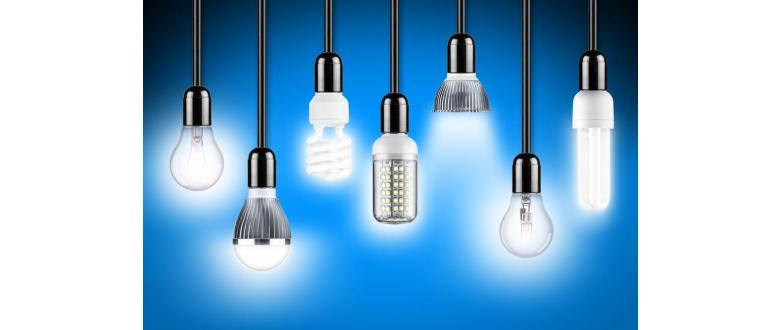April 29, 2020
0 comments
What Kind of Light Bulb Do I Need for Each Room in My Home?
Taking
the confusion out of choosing the right light bulb
Perhaps you feel lost in a sea of light bulbs every time you visit the store for a replacement. Or maybe you’ve never thought “what light bulb do I need?” and you just grab whatever’s least expensive. Either way, there’s a lot more to choosing light bulbs for your home than meets the eye. We’re here to help you select the bulbs that best fit your specific lighting needs, whether you’ve ever scratched your head and wondered, “what color light is best for my kitchen?”—or not.
Does
it really matter which kind of light bulb I choose?
Choosing the right light bulbs for each room in your home is more important than many people realize. Research indicates that the way a space is lit affects people psychologically and physiologically in terms of performance, perception, behavior, and more. Without adequate levels of light, people cannot perform tasks safely or efficiently—while very bright lights and sharp contrasts in illumination can cause fatigue and distraction.
The amount and quality of light we’re exposed to at different times of day affect our mood, alertness, and ability to sleep at night. There’s even research indicating that certain types of light exposure may be linked to diseases like cancer, diabetes, heart disease, and obesity.
On a less worrisome note, lighting also impacts the way we perceive colors and textures. Warmer light will bring out tones of red, orange, and yellow in a room’s décor (and in our skin and hair) and will suppress hues like blue, green, and purple. Cooler lighting will have the opposite effect.
To optimize your home’s lighting, you need to consider several things:
- Function: How do you use each room in your house?
- Appearance: How will the light bulbs you choose affect the way the paint, fabrics, artwork, etc. in the room look?
- Mood: How do you want to feel when you’re in the room—calm, energized, focused, relaxed?
Evaluate
these four variables when asking, "What kind of light bulb do I
need?"
We’ve discussed the ways the brightness and color of a room’s lighting can affect mood, energy levels, health, safety, and more. When choosing light bulbs for each area of your home, you will also want to consider the energy efficiency of each bulb and whether you might benefit from installing dimmable lights in certain spaces. Let’s explore the specifics of what to look for when shopping for bulbs:
Wattage
Wattage is a measure of the amount of electrical power that a light bulb uses. For safety’s sake, you will need to know the maximum wattage rating of each fixture in which you are installing a light bulb. The higher a bulb’s wattage, the more electricity it uses, and the more heat it creates. Lower-wattage light bulbs are more energy-efficient.
Note: If a light bulb uses more watts than its fixture is rated for, it may overheat and could cause a fire. Never install a light bulb with wattage in excess of the light fixture’s rating.
Lumens
Lumens describe how much light, or brightness, a given light bulb emits. Choose bulbs that provide the right amount of light for the intended room. You’ll need to take into account the size and function of the room, as well as how it’s decorated. Dark colors absorb more light than light colors. Hallways, living rooms, and bedrooms typically require less light than kitchens, offices, and bathrooms. Here is a list of suggested lumens for each room in your home:
- Kitchens: 5,000–10,000 total lumens
- Bathrooms: 4,000–8,000 total lumens
- Bedrooms: 2,000–4,000 total lumens
- Living rooms: 1,500–3,000 lumens
- Dining rooms: 3,000–6,000 lumens
- Home offices: 3,000–6,000 lumens
Color
Some manufacturers provide colored light bulbs, and you may be interested in exploring these for mood lighting or parties—but that’s not what we typically mean when we refer to a light bulb’s color. Many people think that standard light bulbs produce white light. Actually, “white” light bulbs come in a range of color temperatures.
Light color is measured using something called the Kelvin Temperature Scale. Temperatures range from a very yellow 2700k to a much bluer light at 6500k. Lower light temperatures typically feel warmer and create a feeling of relaxation while higher temperatures feel cooler, clarify details, and provide a more energetic atmosphere.


So, what color light is best for a kitchen? “Warm white” lighting is generally considered better for rooms where you want a cozy, relaxed ambiance like bedrooms, living rooms, and dining rooms. “Cool white” lighting works well in kitchens, bathrooms, and offices where alertness and attention to detail are often important. “Daylight” bulbs provide sharp color contrast and are more appropriate for basements, garages, and reading lamps.
Dimmability
If you own dimmable light fixtures, you will want to install dimmable light bulbs. There are many benefits to being able to dim a room’s lights. When you first wake up, bright lights might seem harsh and overwhelming. As your eyes adjust, turning up a dimmer switch can help you become more alert and see what you’re doing more easily.
In the evening, you may want to gradually turn down the lights in your living room, kitchen, or bedroom as you complete your tasks and prepare to relax and get ready for bed. Lower dining room lighting can create a lovely ambiance for a dinner party, while dimmable hallway lighting can increase night-time safety without fully rousing you from a sleepy state.
Incandescent,
halogen, fluorescent, or LED: Which light bulb do I need?
There are four types of light bulbs typically available for residential use: incandescent, halogen, fluorescent, and LED. Incandescent light bulbs produce a warm color and are inexpensive. As they emit a lot of heat, they are not very energy efficient. Since legislation requiring greater efficiency for household light bulbs passed in 2007, they also aren’t as widely available as they used to be.
Halogen bulbs are very similar to incandescent bulbs, in that they’re low-cost and relatively inefficient. They do, however, last approximately three times as long as incandescent bulbs.
Fluorescent light bulbs are energy efficient and have a lifespan several times longer than that of halogen bulbs. They produce cooler light, which may or may not be desirable in a given space. Unfortunately, they can also take time to “warm up” after turning on, are difficult to dispose of safely (as they contain poisonous mercury), and they may not be dimmable.
LED light bulbs are very energy efficient, producing the same lumens as an incandescent bulb for a fraction of the watts. They are also extremely long-lasting, with an average lifespan of 25,000 hours. They do cost significantly more than other types of light bulbs, but this is offset by the cost-savings and convenience of less-frequent replacement. And perhaps most exciting, many LED-based bulbs have built-in “smart” technology—allowing them to be controlled by a smart home hub or mobile phone app.
Smart
lighting delivers considerable benefits to homeowners and renters
The ability to automate our lives at home and away has rapidly expanded in the last few decades. Smart home appliances now collect and share information with us, do some of our work for us, and can be controlled remotely, by voice command, or by customized programs. Residential smart technology provides advantages in safety, security, convenience, and energy efficiency—and smart lighting is no exception.
Frontpoint’s smart lighting can be remotely controlled through a central hub using your smartphone, tablet, computer, or voice commands to a smart speaker like Amazon Alexa or Google Home. There’s even a Keychain Remote that allows you to turn your lights off and on, dim them, arm or disarm your security system, and more from up to 100 feet away.
Transform your dark home into an inviting oasis while you’re pulling into the driveway after a long day at work. Easily turn your home’s lights off after you get into bed, rather than walking through the house in the dark. Save energy by checking the status of your lights when you’re away from home and turning them off during the day.
Optimize
your home’s lighting with automation
There are several ways to automate smart lighting. You can create "lighting scenes," which can be activated by a mobile app, a verbal command, or the location of your smartphone, or be set to occur on a schedule. If you integrate smart lighting into a smart home security system, certain lighting scenes can even be triggered if your intrusion sensors, motion detectors, surveillance cameras, or environmental sensors are activated.
Geo-fencing can initiate lighting scenes based on where you are. Set your lights to shut off when your smartphone crosses your home’s geo-fence for the office every morning, and to turn back on when you arrive home. Program your smart lights to turn on in any room where a door/window or motion sensor is tripped. Ask your security system to automatically activate your hallway lights and entryway lights if your smoke and heat sensor or carbon monoxide sensor sounds an alarm.
Schedule bedroom and kitchen lights to come on before sunrise for early morning risers. Set porch lights to turn on when the sun goes down. Motion sensor activation could turn on low lighting to light the way to the bathroom if it senses you’re out of bed. Create a "dinner party scene" to quickly dim kitchen and dining room lights when guests arrive, or a “naptime scene” to turn off nursery lights and turn on the hallway light while the baby is sleeping.
Automating your lighting even helps with home security. Homes that are left dark at night attract thieves because they appear empty, as do homes that have the same lights left burning all the time. Even lights on simple, predictable timers can indicate a vacant house to criminals who case a property for several days before breaking in (as occurs in about one-third of these types of crimes). Scheduling smart lights to turn off and on in a seemingly random sequence makes it looks like someone is home, even when you're thousands of miles away on vacation.
Frontpoint
offers two smart lighting solutions


The Smart Light Bulb is similar to a standard light bulb in terms of electrical components and outward appearance. This smart LED bulb screws into a light fixture in the same way a regular light bulb does. However, it’s also dimmable, energy-efficient, and uses built-in Z-Wave technology to communicate with the Frontpoint Hub.


Frontpoint’s Wireless Light Control is great for remotely controlling lights that don't use a standard-size bulb. Plug the Wireless Light Control into an electrical outlet and then plug any light, lamp, or other small appliance into it to control their activities.
You can optimize your home’s lighting by considering how you use each room, the mood you’re trying to create, and the specific qualities of each light bulb you select. Regardless of the solution you choose, one thing is clear: making any given light “smart” provides convenience and safety benefits that traditional lights can’t match.
Frontpoint keeps homes safe whether families are there or not. We've been revolutionizing the home security industry for over a decade. And we're just getting started. To shop DIY home security systems, check out our Security Packages. If you have questions or would like to discuss a quote, contact us at 1-877-602-5276.







 Contact us
Contact us